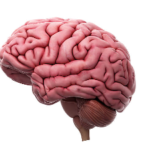Turmeric comes from a green leafy flowering plant called Curcuma Longa, which due to its need for an environment with regular rainfall and temperatures between 20 and 30 °C, grows mostly in tropical wet climates and is native to the Indian subcontinent and Indonesia. Turmeric is not stored inside the leaves of Curcuma Longa but inside the rhizomes. Rhizomes look like roots but differ to roots in that rhizomes are storage vehicles for the plant and grow like underground modified stems. Curcuma Longa comes from the same family as Ginger (Zingiberaceae) and the rhizomes of both look similar except that when cut open, Turmeric has a deep yellowy orangey colour compared to Ginger.
Turmeric has been used for many different purposes in the past including its use as an a aromatic spice in cooking for its preservative qualities as well as taste. Its dried powder is also frequently used for colouring foods yellow such as mustard, butter, margarine and Cheddar cheese.
It was also used as an ancient dye for fabrics and skin as well as its many medicinal purposes. In fact in Vedic Sanskrit, the ancient language of the Vedas which is where Ayurvedic medicine comes from, Turmeric is known as Kanchani which translates as the ‘Golden Goddess’. Ayurverdic medicine dates back over five thousand years and Turmeric is one of the five sacred Ayurvedic herbs. Not only was Turmeric used in Ayurvedic medicine but is was also used in traditional Chinese medicine and Siddha medicine.
Although the medicinal properties of Turmeric were known for thousands of years, it wasn’t until the early nineteenth century in 1815 when the scientists Vogel and Pelletier isolated the active ingredient in Turmeric which provides all its medicinal properties. They described the isolation of a “yellow coloring matter”. The isolated substance discovered by Vogel and Pelletier was said to be a mixture of resin and Turmeric oil.
In 1842, Vogel isolated a pure form of Curcumin but the chemical structure of Curcumin eluded scientists for decades with many scientists postulating a possible structure without success until 1919 when Milobedzk and Lampe discovered the chemical structure which was named diferuloylmethane. Diferuloylmethane is also known as 1,6-heptadiene-3,5-dione-1,7-bis (4-hydroxy-3-methoxyphenyl)-(1E, 6E).
In 1949 Schraufstatter et al submitted a paper to the journal ‘Nature’ arguing that Curcumin has anti bacterial properties and was active against strains of Staphylococcus aureus (commonly known as ‘Staph’, Salmonella paratyphi caused by Salmonella enterica, Trichophyton gypseum – a genus of fungi, and Mycobacterium tuberculosis which is the bacterium that causes tuberculosis.
The list of benefits, although not exhaustive, that Curcumin is purported to help with includes Anti-Tumour (helps prevent and fight cancers), Anti-oxidant (helps fight aging), Anti-Arthritic (helps fight arthritis), Anti-Amyloid (combined with Vitamin D helps treat Alzheimer’s disease), Anti-Ischaemic (helps prevent heart attacks), Anti-Inflammatory (inflammation is believed to be involved in most major diseases), hepatoprotective (helps with liver protection), Anti-Viral, Anti-Bacterial, Anti-Septic, Anti-Fungal, Anti-Malarial, Anti-Atherosclerotic (helps counter hardening of the arteries).
How Not to Die by Dr. Michael GregerAlthough there have been over 4000 studies about Curcumin many with positive results, there needs to be further studies. The problem with studying Curcumin however is that because it is a natural substance that is extracted from a plant, it is not possible for Big Pharma to copyright it. It remains as a supplement and is very rarely recommended in the doctor’s surgery as an adjunct or alternative to many of the medicines prescribed. Turmeric only contains 2% – 5% Curcumin which means that the best way to take curcumin is by way of supplement.
Curcumin has a number of advocates and supporters. The famous scientist, author, futurologist and now director of engineering at Google, Ray Kurzweil, believes that he can achieve immortality by using existing medical technologies to stay alive long enough to be around for the next lot of medical technologies that will allow him to live forever. Ray Kurzweil is reported to take up to 250 supplements per day and monitors a battery of biological data in order to achieve his goal. On page 250 of his book ‘Fantastic Voyage: Live Long Enough to Live Forever’ he writes about both Turmeric and Curcumin and suggests that people should regularly use Turmeric as part of food preparation and also advises everyone to take Curcumin supplements of 900 milligrams per day for cancer prevention as he does himself.
In a later book called ‘Transcend: Nine Steps to Living Well Forever’, Kurzweil states that the use of statin drugs lower cholesterol levels and reduce inflammation and that lowering inflammation maybe a more important effect for treating heart disease than the lowering of cholesterol. Kurzweil suggests that Curcumin could be used as a useful adjunct for heart disease. In his book, Kurzweil also cited a scientific study from 2008 in which Curcumin was combined with a Green Tea extract (Epigallocatechin Gallate) and was shown to suppress breast cancer cells in test tubes as well as mice. Another study from 2008 was also shown to suppress bladder cancer cells in test tubes.
Curcumin has also been advocated by Dr. Michael Greger who supports Plant Based Nutrition in order to prevent and even reverse some of the most prevalent diseases including heart disease. In his book, a New York Times Best Seller, ‘How Not To Die: Discover the foods scientifically proven to prevent and reverse disease’, Dr. Greger said that amongst other things, Turmeric may be protective against radiation damage, cancers, brain disease, Lupus and that Turmeric may be a better choice than Aspirin. The active ingredient in Aspirin is Salicyclic acid but it is also found in Chili, Paprika and Turmeric and therefore Turmeric could provide the same health benefits as Aspirin but without the side effects. Dr. Greiger also reports in his book that Curcumin has been shown to aid faster recovery post surgery.
One of the largest studies ever undertaken into human nutrition was called the ‘China Study, The: The Most Comprehensive Study of Nutrition Ever Conducted and the Startling Implications for Diet, Weight Loss and Long-term Health’ and it looked at the eating habits of Chinese people living in different areas across China. The study compared rural populations against more industrilaised populations and sought to discover if there was any relationship between diet and health outcomes. The study crunched a massive amount of data and as well as suggesting that animal protein was contraindicated in terms of good health, the study also suggested that the populations that ate the most fruit and vegetables including anti inflammatory foods such as Turmeric had the best health outcomes in terms of lower rates of Heart Disease, Cancer and Stroke.





